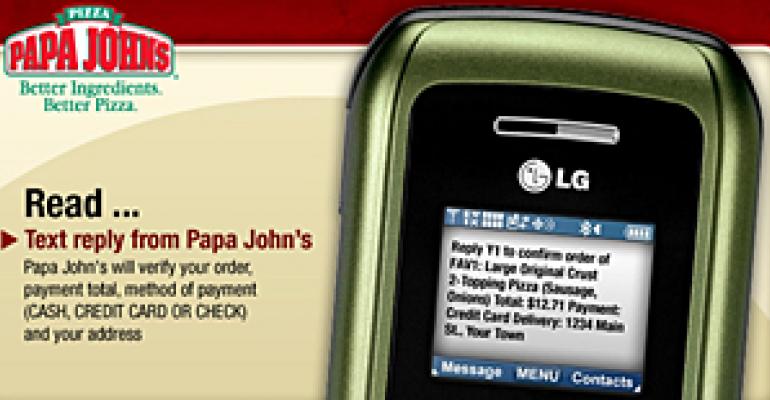LOUISVILLE Ky. Officials of Papa John's Pizza, based here, say a text message ordering application launched late last year is delivering "sales lift" to the chain's approximately 2,700 U.S. stores.
Glenn West, Papa John's senior vice president of information services and e-commerce, declined to quantify that lift or specify the number of consumers who have registered to use the service. However, he said increased sales attributable to the application — launched in November as an enhancement of an online ordering option introduced by the chain in 2001 — warrant plans to extend it to Papa John's markets outside the United States.
Both West and Mark Nance, Papa John's director of e-commerce and application development, noted that cell phone trends and their chain's mission to be as convenient a source of meals as possible made support of text message ordering a logical move.
"There are more than 100 million active cell phone users in the U.S., and virtually all phones have text-messaging capability," West said. "We felt that leveraging this fact would make good competitive sense."
Papa John's decision makers believe that comparative ease of use makes a text-based ordering application a "better bet" than so-called "mobile Web" alternatives, such as is supported by Domino's Pizza at more than 2,700 U.S. units. A mobile Web order system lets users order anything they desire — not just pre-programmed favorite combos — but they must do so using browser software and the relatively small display screens and keypads of Internet capable cell phones or personal digital assistants.
Papa John's largest rival, Pizza Hut, has said it supports text-message and mobile Web orders at about 6,200 U.S. restaurants.
To utilize the Papa John's system, customers first must create an account on the chain's website at www.papajohns.com. This entails selecting four favorite orders from an online menu and designating them "FAV1," "FAV2," "FAV3" and "FAV4." Diners also register a primary delivery address labeled "SAV1" and, if desired, additional delivery destinations, such as their offices. Storing credit or debit card data, encrypted on the website and protected via Papa John's PCI compliance, is optional.
Because favorite orders and other critical information are already in the system, customers can place orders quickly, even, conceivably, while in their vehicle and stopped at a red light. "All they need to do is text 4PAPA, then enter FAV1, FAV2, FAV3 or FAV4 and, if necessary, any deviation from the address and payment default preferences," Nance said.
Once placed, orders hit the operator's proprietary online ordering system through an interface built in conjunction with systems design firm Wiseoutlook of Tallahassee, Fla. Papa John's sends a reply, and customers have the option to change or confirm both the content and the destination of their orders.
Based on geographic codes built into the application, the system determines which Papa John's store should receive orders and routes them to the appropriate unit. Orders simultaneously pop up in stores' point-of-sale systems, which run a homegrown program called Profit, and on their "make lines," where they are displayed on kitchen monitors.
Kitchen printers interfaced with the monitors generate slips containing order details, while at the same time, labels bearing customers' address and order information are produced at the point of sale and affixed to pizza boxes. Separate point-of-sale receipts for customers paying with credit cards also are created at this time.
According to Nance, integrating the Web-based order acceptance application with Profit was an uncomplicated endeavor. "The two systems are built on the same platform, so the only big piece was to write the geospatial coding," he said.
He added that customers also can utilize the text messaging function to locate the nearest Papa John's store that will deliver to a particular location, as well as to find out about special in-store deals and promotions. The former is accomplished by sending to 4PAPA a text message containing the ZIP code that corresponds to the desired delivery address; the latter, by conveying a message saying, "deals." Diners currently must telephone a store to order items promoted through a "deals" message, but future enhancements to the system may make it possible to take advantage of the offer via text message.
"We're really at the tip of the iceberg with text messaging," West said. "Online orders still outstrip text-based orders by a wide margin, but as we proceed up the learning curve and enhance the system, that gap will narrow. We're very satisfied with the progress to date."




